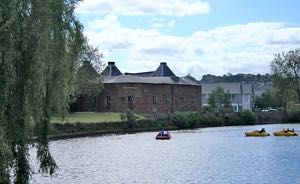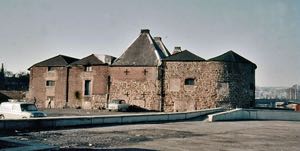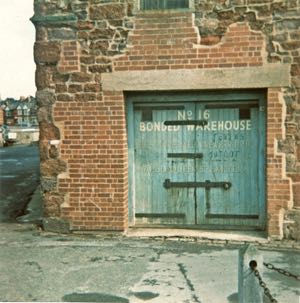
Malt House - Haven Road
Page updated 16th February 2016
This pub and family restaurant is situated in an old Malthouse that dates back to the 18th-century. Brewing was well established in Exeter, probably because of the proximity of the ingredients to make beer and a growing urban population. At its height, there were 15 breweries in the city.
Purpose built in 1789 as a brewery and cellar by the St Thomas Brewery of Opie Smith and Edward at Shooting Marsh Stile. It was taken over in 1833 by the City Brewery, who were situated on the opposite bank of the river, by the lower leat. Brewing ceased in 1850 and the premises underwent changes over the ensuing years to increase its malting capacity. The St Thomas Brewery also had premises in Okehampton Street, close to where the present Royal Oak is situated. The malthouse closed in 1949, and became a bonded warehouse. The building was converted into a family restaurant and pub called the Malthouse, in 1995.
The original building was a basic rectangle in design, with one long side built as a convex wall. Three parallel, tiled roofs were built over. Two years later, a malthouse was added to the straight, long side of the original brewery.
Both brewing and malting continued in the enlarged complex and in 1833 the whole was incorporated into the City Brewery. By 1850, brewing had ceased and malting had taken over the whole of the premises.
Producing Malt
Malt is an important ingredient in the brewing process. Grain is slowly dried in store, before being steeped in water for two to three days and spread over a frame to begin gemination - this is when the starch in the grain is converted into maltose. The germination takes four to five days in a cool atmosphere. The sprouted grain is then heated in a malt kiln, which halts the germination and dries the grain to between 3 to 6% moisture. The last processremoves the tiny rootlets that sprouted in the germination, by tumbling the sprouted malt in a drum.
In 1876 two small conical malting kilns were installed in the building on the opposite side to the river bank. Extra floors were also added internally. In 1900 three larger conical malting kilns were built, one replacing one of the 1876 kilns. The kilns were finally closed in September 1949.
Before the building was converted into a family pub, it was used as a bonded warehouse for a time, and then, in the 1970s and 80s, Magnet Windows and Kitchens had a showroom there. In 1989, Lovell Urban Renewal of Swindon submitted plans to turn the building into a hotel. In the event it was in 1995, that Exeter Archeology investigated the site before Brewers Fayre took it over. The main bar, eating areas and children's area are housed in the original maltsters built in 1791.
 The Malt House is now a Harvester family pub.
The Malt House is now a Harvester family pub. The Malthouse circa 1970, when it was still a bonded warehouse. Photo
Alan H Mazonowicz
The Malthouse circa 1970, when it was still a bonded warehouse. Photo
Alan H Mazonowicz
 The doors for the bonded store. Photo Nigel Bush.
The doors for the bonded store. Photo Nigel Bush.
│ Top of Page │